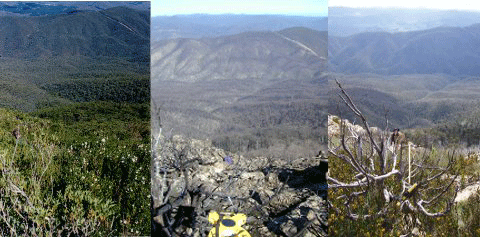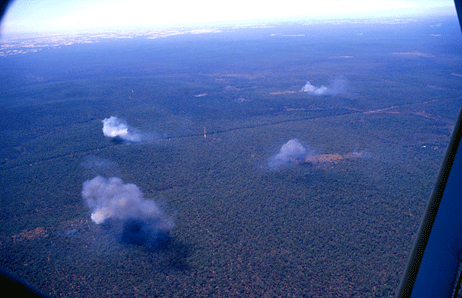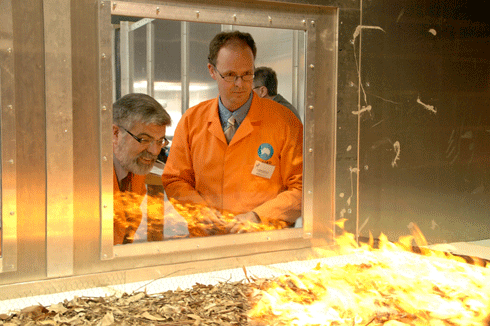
|
Published: 22 March 2012
Limits to managing the landscape with fire
The practice of controlled burning – whether to protect property (fuel reduction burns) or biodiversity (ecological burns) – continues to divide public opinion. However, scientists remind us that controlled burns can only achieve so much, and that the risk of fire will never be completely removed from the Australian landscape.

|
|
Epicormic (vegetative) regrowth from the bark of a eucalypt at Strathewen, four months after Victoria’s Black Saturday bushfires.
Credit: Robert Kerton
|
In a recent issue of the peer-reviewed International Journal of Wildland Fire , a team of Australian scientists discussing the issue of prescribed burning point out that ‘from an ecological perspective, the problem is not with fire itself, but with inappropriate fire regimes’ – the pattern of fire prevailing in a region, in terms of seasonality, intensity, interval between burns, frequency and so on.
Australia’s well-established priority for fire management is protecting life and property, but in many areas – such as national parks, forests and woodlands – conserving biodiversity is also vitally important.
While all components of a fire regime can potentially affect biodiversity, fire frequency has received the most attention.
Both too-frequent and infrequent burning can significantly change biodiversity. The season in which the burn occurs can also affect certain species. Scientists generally agree that variations in fire frequency, season of burning, and intensity can increase a landscape’s ‘heterogeneity’: providing a greater range of habitat types, and vegetation ages and structures.
Fire intensity and plant recovery
To measure the impacts of fire and its management on biodiversity – and also to identify the species most susceptible to fire – long-term monitoring is required.
For the past nine years, CSIRO plant ecologist, Mr Michael Doherty, has been measuring vegetation recovery rates following the fires that swept through the Australian Capital Territory and New South Wales high country in January 2003.
The results from his study of 163 plots in the New South Wales Brindabella Ranges reveal a rapid recovery of plant species and vegetation structure in areas that experienced low-intensity fire. In places that experienced a higher intensity burn, the vegetation is also returning to its pre-fire state, but more slowly.

|
|
An area of the Brindabella Ranges in 1997 (left), before the 2003 ACT fires; soon after the fires (middle); and in 2010 (right).
Credit: CSIRO
|
‘Even at the high fire-intensity extremes associated with large infrequent fires, montane ecosystems appear to be fairly robust,’ says Mr Doherty.
‘In terms of overall species richness and composition, the results suggest that irrespective of fire intensity, the vegetation will recover to be similar to its pre-fire state.’
However, he adds that after high-intensity fire, fire-killed eucalypt species (e.g. alpine ash) that have to regenerate from seed may take longer to recover. It may be 20–30 years before there are enough mature trees with seed to withstand the next fire. 1
Although many forests in south-eastern Australia are dominated by resprouting species that can withstand high-intensity fire, they also contain some species that are more sensitive to shorter fire intervals.
The savanna woodlands of northern Australia, in contrast, are composed almost entirely of resprouting species that respond to regular controlled burns.
Estimating impacts of fuel-reduction burns
While prescribed burning is often used to reduce fuel loads and protect property, less frequently, it is used to protect habitat and species. A typical management objective for such ecological burns is to maintain the distribution of species that are particularly susceptible to fire within the local landscape. 2
Professor Ross Bradstock leads a research team at the University of Wollongong’s Centre for Environmental Risk Management of Bushfires. His team is looking at potential trade-offs between different fire management objectives.
Prof. Bradstock says most fire managers now talk in terms of managing risk – e.g. the risk of loss to property, species or water supplies. But the rate and extent of prescribed burning is a controversial issue. No one really knows the effect of a particular level of treatment.
‘How much does a certain level of management input (e.g. prescribed burning) reduce the risk to a particular asset – such as area burnt, houses lost, species put at risk?’ he asks. ‘And, how do we measure that?’
‘One way of looking at it is to say, “for each hectare I treat, what is the payoff in change in long-term fire activity?”.’ This concept, known as leverage, gives fire managers a way to quantitatively evaluate different approaches.
‘In the forests of southern Australia, the best you will ever get is three to four hectares burnt as fuel reduction to reduce wildfire by one hectare (i.e. a leverage of 0.25 to 0.3),’ Prof. Bradstock explains.
‘In the savanna grasslands of northern Australia, the figure is about one: burn one hectare by prescribed burning, and you will save one hectare from being burnt later in the dry season by unplanned fire.’
In New South Wales, about one per cent of fire-prone landscapes is treated with prescribed fire. ‘In terms of risks to people and property, that probably has a small effect,’ says Prof. Bradstock.

|
|
Researchers hope to provide land managers with more effective tools to assess and mitigate fire risk. For example, Project Vesta – one of Australia’s most comprehensive studies of forest fire behaviour – investigated the behaviour and spread of high-intensity bushfires in dry eucalypt forests with different fuel ages and understorey vegetation structures. This photo records experimental fires in southwestern Australia aimed at identifying different burn rates in different aged fuels in four locations.
Credit: CSIRO
|
The 2009 Victorian Bushfires Royal Commission recommended treatment of five per cent of public land for fuel reduction. This would probably reduce wildfire risk by less than half, says Prof. Bradstock, and would cost several hundred million dollars per year across south-eastern Australia to implement.
‘In the long term, in order to reduce risk considerably, you need to burn quite a lot of the country,’ he says. ‘Is it achievable? Can we afford to do it, and what other costs might be involved, such as loss of biodiversity?’
Whatever the cost, it will involve trade-offs. The work of Prof. Bradstock’s team is giving land managers the information they need to find better solutions.
The leverage concept can also be used to investigate ecological impacts, such as using prescribed fire to mitigate carbon emissions from wildfires.
‘At a leverage of 0.25, that is unlikely to occur, because the outlay of carbon emissions from the prescribed burning is probably more than you are going to save,’ says Prof. Bradstock.
The team is also investigating prescribed burning and the long-term implications of different rates of prescribed fire. Using simulation models that allow them to vary rates of treatment, the researchers have gained insights into the long-term relationships between the amount of effort and the resulting change in subsequent fire activity.
Recent research has highlighted the lessons for property protection from major fires, such as Victoria’s 2009 Black Saturday fires. According to Prof. Bradstock, factors such as clearing land very close to a house (where the house is near a forest) and the type of garden have the biggest impact on the probability of a house being destroyed.
He adds that if land managers want to treat fuel loads to protect people while minimising impacts on biodiversity, some areas may need to be sacrificed.
‘The best places to sacrifice are the environment around and close to property,’ he says. ‘We may be able to do that in such a way that across the whole landscape, we are not compromising the integrity of species.
‘There may be sacrifice zones where we can get the greatest bang for our buck in terms of protecting people. We accept that there will be some ecological changes, but in the greater scheme of things, they will be minor.’
Prediction to aid in faster suppression
CSIRO’s Bushfire Dynamics and Applications Group develops tools to help fire agencies improve their speed and effectiveness in predicting, locating and quelling fires.
A key aspect of fire under extreme conditions is ‘spotting’. The CSIRO group is looking at the potential of different vegetation types – especially eucalypt forests – to generate fire ‘brands’ downwind of the main fire.
Candlebark and ribbon bark trees, for example, shed long streamers of bark that can be ignited by fire from beneath, blown aloft and transported downwind.
Team leader Dr Andrew Sullivan says that, according to the literature and anecdotal evidence, these firebrands can be lofted as far as 40 kilometres in some types of vegetation.
In the conditions experienced on Black Saturday, there was a high potential for lofting of firebrands downwind of the main fire. This created danger for both firefighters and people trying to escape.
The CSIRO work should help fire managers pinpoint the areas where spot fires are likely to start, providing a focus for pre-emptive action.
The team is also investigating potential changes in fire behaviour under climate change.
Dr Sullivan says while modelling studies suggest there won’t be much change in fire behaviour during the peak of the fire season, the evidence suggests the shoulder period at the beginning and end of the season will be longer.
‘The implications are for potentially more wildfires in late spring, extending well into autumn, and also an impact on our ability to carry out prescribed burning.
‘The windows of opportunity for prescribed burning will be smaller, although in some years, burning in winter may be possible under the expected drier conditions.’
With or without climate change, and despite their best efforts, the key message from fire researchers is this: the extent to which we can control fire regimes varies from place to place, and in some places is very limited.
|
Bradstock RA, Gill AM, Williams RJ (eds) (2012) Flammable Australia Fire Regimes, Biodiversity and Ecosystems in a Changing World . CSIRO Publishing, Melbourne. |
Bradstock RA, Cary GJ, Davies I, Lindenmayer DB, Price OF, Williams RJ (in press) Wildfires, fuel treatment and risk, present and future: mitigation by what degree? Journal of Environmental Management. |
Bradstock RA, Boer MM, Cary GJ et al. (in press) Modelling the potential for prescribed burning to mitigate carbon emissions from wildfires in fire-prone forests of Australia. International Journal of Wildland Fire. |
Gibbons P, van Bommel L, Gill AM et al. (2012) Land management practices associated with house loss in wildfires. PloS ONE. |
Penman TD, Christie FJ, Andersen AN et al. (2011) Prescribed burning: how can it work to conserve the things we value? International Journal of Wildland Fire. |
1 Editor: Mountain ash forests are regarded as particularly fire-sensitive. In a paper published last year in the US journal, Proceedings of the National Academy of Sciences , a research team led by Australian ecologist Professor David Lindenmayer argued that the replacement of large areas of mature mountain ash with immature stands created through logging puts these forests at higher risk of ‘mega’ fires.
2 Editor: For example, in Victoria, one of the most bushfire-prone areas in the world, ‘inappropriate fire regimes causing disruption to sustainable ecosystem processes and resultant loss to biodiversity is listed as a potentially threatening process’ according to the state’s Flora and Fauna Guarantee Act 1988. See Department of Sustainability & Environment website.






